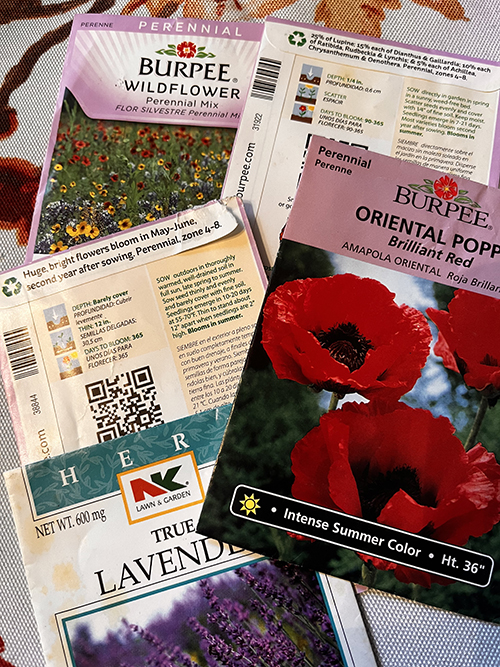Let It Grow
By Tammy Thornton
Normally, when we think of planting seeds in the garden, we picture the refreshing early days of spring after we have survived another cold, dark winter. However, did you realize that certain seeds need a period of cold, wet weather to germinate and flourish? While some seeds can and should wait until after the last frost of spring, others need a time of cold to break their dormancy. Seeds of perennial plants that are native to the cold winters of the Northeast will often fall into the category of requiring a process called cold stratification. This is the cycle of exposing seeds to the cold, wet, freezing, and melting of winter, which will aid in breaking the dormancy of some seeds while softening the hard outer shells of others.
Cold stratification can be achieved in several ways. For one, you can allow cold stratification to occur naturally. Picture the current state of your purple coneflowers, for instance. Some of the flower heads have now gone to seed, and you are left with those wonderful thistle-like seed heads. If you keep a close eye on them, you may have noticed goldfinches (our state bird) balancing on the seed head while tugging at the seeds with their beaks. Inevitably, some of these seeds will fall to the ground and will be forgotten and unnoticed throughout the winter months. The seeds that are resting on the soil will be exposed to rain, cold, and possibly snow, while we are warmly snuggled under blankets in our homes. Instead of feeling bad for these poor little exposed seeds, take heart — they are going to be your star pupils in the germination class. At just the right time, they will wake up in the spring and be ready to start their journey of growth and bloom. This period of “hardship” that they have endured in the cold months will have equipped them with the best chance of reaching their potential in the garden. Who knew that coneflowers could teach us a lesson in being hopeful through hardship? If you want to trust nature to do its work, plant seeds requiring cold-stratification directly in the garden in the fall. But wait until cold weather is here to stay, or your seeds will germinate prematurely.

Read your seed packet carefully, and you will see telltale signs like “365 days to bloom”. These types of seeds should be cold stratified.
If you are the type that wants to have a little more control over the situation, you can use other methods that will mimic the cold stratification found in nature. The paper towel method consists of placing your seeds on a moist (but not overly wet) paper towel, inserting the paper towel into a zipped baggie, and chilling it for several months in the refrigerator. You will find different variations of this method, such as using sand or vermiculite in the bags, soaking the seeds overnight first, or differing the lengths of time that the seeds are chilling in the freezer or refrigerator. Another method that I have attempted myself and found very successful is the “winter sowing” method. The seeds are sown outside during the winter months but are planted in sealed containers such as milk jugs. Holes for drainage are added to the container and the cap is removed to expose your seeds to rain and snow. Like a miracle, at just the right time, you will see little seedlings emerge in the spring.
In addition to coneflowers, some of the seeds that will germinate more successfully after cold stratification are: lupine, milkweed, goldenrod, bee balm, lavender, false indigo, black-eyed Susan, columbine, money plant (honesty) and poppies. Years ago, I wrote an article called “Sowing Poppies in the Snow” when I discovered that you can sprinkle poppy seeds over the snow, and they will begin to grow in the spring after the snow melts. Tulips and other spring bulbs follow this same principle of needing a period of cold to cause them to bloom in the spring.
If you aren’t sure which seeds need cold stratification, check the backs of seed packets. Some of them will indicate that it will take two seasons before the flowers bloom, and others will plainly state that the seeds need cold stratification. If you have planted certain seeds in the spring or summer and were disappointed because the flowers did not bloom that year, they might just be waiting for a cold winter. You can cheat the system and speed the process by planting these seeds in the fall or winter, or using a method of mimicking the cold.
We would love to hear about your successes (or educational failures) in the garden. Send your comments or questions to shorelocalgardener@gmail.com.
Tammy Thornton lives with her husband, children, and crazy pets while enjoying a life of gardening, cooking, and going to the beach.










